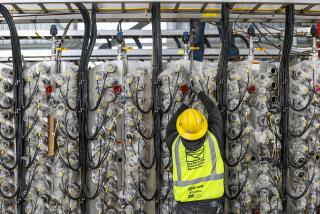GM to set aside $773 million to clean up old factory sites
- Share via
In an agreement that could pump new economic life into depressed communities from the Midwest to the East Coast, General Motors Co. will create a $773-million trust fund to clean up pollution at old factory sites and prepare them for new uses and investment.
The money, put up under a deal negotiated with state and federal officials as part of GM’s plan to emerge from bankruptcy, is earmarked for 89 projects in 14 states.
While the ultimate goal of the cleanup is to rehabilitate the abandoned sites and turn them over to new businesses, the most immediate benefit may be the jobs created in areas that have been especially hard hit by the decline of the U.S. auto industry and the recession.
“The agreement marks a new beginning by responsibly addressing hazardous waste contamination in impacted communities, and at the same time creates jobs to help clean up and return these sites to beneficial uses,” said Gary G. Grindler, U.S. acting deputy attorney general, in a written statement.
GM agreed to establish the fund as part of its bankruptcy reorganization, for which it expects final approval early next year. More than $300 million of the $773 million would be split almost evenly between Michigan and New York. Michigan’s share would go to cleaning up 56 properties across the state, with most of the money going to remediation work in Flint.
Michigan Gov. Jennifer Granholm, who has made restoration of old industrial sites a cornerstone of her economic development policy, welcomed news of the trust fund. “Cleaning up these former GM sites will allow new companies a greater opportunity to invest in Michigan and create jobs,” Granholm said in a statement.
The nearly $154 million allocated for New York would go to cleaning up two Superfund sites, one in Massena, near the Canadian border, and the other near Syracuse, said Peter M. Iwanowicz, New York state deputy secretary for the environment.
Two-thirds of the 89 sites are contaminated with hazardous waste, according to a statement from the Obama administration. New York got involved early in the GM bankruptcy to make sure it would get the money it needed to rid the sites of PCBs and other compounds that were found at both sites.
“For us, it’s a pretty big deal,” Iwanowicz said. “We’re pleased that New York will receive the resources to clean up the two sites we were concerned about.”
The states would initiate and oversee the cleanup efforts and bill the trust fund for compensation, Iwanowicz said. Like federal officials, he said he saw the potential for short-term job creation from the rehabilitation efforts, and pointed to how the recent dredging of the Hudson River created jobs too.
But the potential cleanup is fueling bigger dreams among officials and environmentalists in states where local manufacturing has all but withered away.
“Cleaning up these contaminated sites is the ‘holy grail’ of redevelopment in New York state,” said Saima Anjam, program associate with Environmental Advocates of New York, a nonprofit advocacy group in Albany, N.Y. “This cleanup will spur new development which provides incentive for businesses to come back to New York. No one wants to live, work or play on contaminated sites, and cleaning them up makes environmental and economic sense.”
Technically, the agreement was reached with Motors Liquidation Co., or Old General Motors, which was created when Detroit’s biggest automaker went under. To give the reorganized GM a better chance of regaining its financial health, many of its old and shut-down plants were turned over to the newly created Old General Motors.







